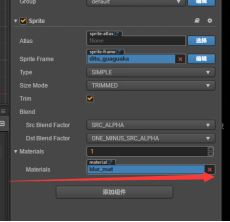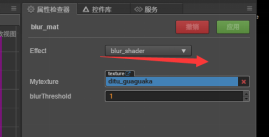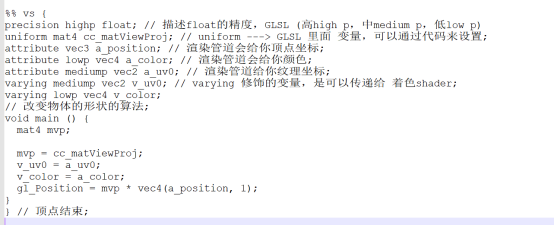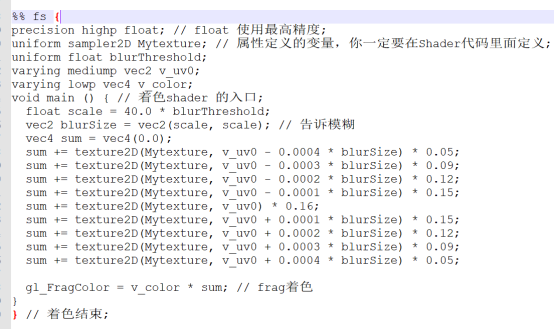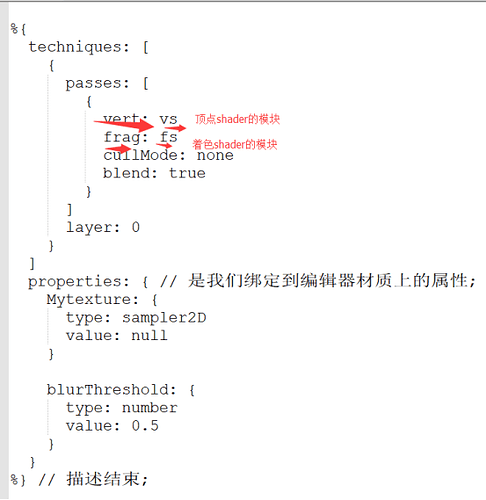主要是参考了这个教程的高斯模糊的Fragment着色器的部分,然后发现需要两次pass,于是就把效果写成了这样:
// Copyright (c) 2017-2018 Xiamen Yaji Software Co., Ltd.
// Note: Current format version is experiment, the format may be changed.
// The future format may not be compatible, you may need to update the script manually.
// 注意:当前版本的格式是实验性的,之后还会进行修改。
// 后续版本的格式不保证兼容当前格式,可能需要手动升级到最新版本。,
%{
techniques: [
{
passes: [
{
vert: vsH
frag: fsH
cullMode: none
blend: true
},
{
vert: vsV
frag: fsV
cullMode: none
blend: true
}
]
layer: 0
}
]
properties: {
iResolution: {
type: vec3
value: null
}
iTime: {
type: number
value: 0
}
texture: {
type: sampler2D
value: null
}
alphaThreshold: {
type: number
value: 0.5
}
}
%}
%% vsH {
precision highp float;
uniform mat4 cc_matViewProj;
attribute vec3 a_position;
attribute lowp vec4 a_color;
#if USE_TEXTURE
attribute mediump vec2 a_uv0;
varying mediump vec2 v_uv0;
#endif
varying lowp vec4 v_color;
void main () {
mat4 mvp;
mvp = cc_matViewProj;
#if USE_TEXTURE
v_uv0 = a_uv0;
#endif
v_color = a_color;
gl_Position = mvp * vec4(a_position, 1);
}
}
%% vsV {
precision highp float;
uniform mat4 cc_matViewProj;
attribute vec3 a_position;
attribute lowp vec4 a_color;
#if USE_TEXTURE
attribute mediump vec2 a_uv0;
varying mediump vec2 v_uv0;
#endif
varying lowp vec4 v_color;
void main () {
mat4 mvp;
mvp = cc_matViewProj;
#if USE_TEXTURE
v_uv0 = a_uv0;
#endif
v_color = a_color;
gl_Position = mvp * vec4(a_position, 1);
}
}
%% fsH {
precision highp float;
// default uniforms
uniform vec3 iResolution; // viewport resolution (in pixels)
uniform float iTime; // shader playback time (in seconds)
// custom uniforms
uniform float intensity;
#if USE_TEXTURE
uniform sampler2D texture;
varying mediump vec2 v_uv0;
#endif
#include
varying highp vec4 v_color;
vec4 blurVar() {
//this will be our RGBA sum
vec2 dir = vec2(1.0, 0.0);
vec4 sum = vec4(0.0);
float radius = 5.0;
//our original texcoord for this fragment
vec2 tc = v_uv0;
//the amount to blur, i.e. how far off center to sample from
//1.0 -> blur by one pixel
//2.0 -> blur by two pixels, etc.
float blur = radius/iResolution.x;
//the direction of our blur
//(1.0, 0.0) -> x-axis blur
//(0.0, 1.0) -> y-axis blur
float hstep = dir.x;
float vstep = dir.y;
//apply blurring, using a 9-tap filter with predefined gaussian weights
sum += texture2D(texture, vec2(tc.x - 4.0*blur*hstep, tc.y - 4.0*blur*vstep)) * 0.0162162162;
sum += texture2D(texture, vec2(tc.x - 3.0*blur*hstep, tc.y - 3.0*blur*vstep)) * 0.0540540541;
sum += texture2D(texture, vec2(tc.x - 2.0*blur*hstep, tc.y - 2.0*blur*vstep)) * 0.1216216216;
sum += texture2D(texture, vec2(tc.x - 1.0*blur*hstep, tc.y - 1.0*blur*vstep)) * 0.1945945946;
sum += texture2D(texture, vec2(tc.x, tc.y)) * 0.2270270270;
sum += texture2D(texture, vec2(tc.x + 1.0*blur*hstep, tc.y + 1.0*blur*vstep)) * 0.1945945946;
sum += texture2D(texture, vec2(tc.x + 2.0*blur*hstep, tc.y + 2.0*blur*vstep)) * 0.1216216216;
sum += texture2D(texture, vec2(tc.x + 3.0*blur*hstep, tc.y + 3.0*blur*vstep)) * 0.0540540541;
sum += texture2D(texture, vec2(tc.x + 4.0*blur*hstep, tc.y + 4.0*blur*vstep)) * 0.0162162162;
//discard alpha for our simple demo, multiply by vertex color and return
return v_color * vec4(sum.rgb, 1.0);
}
void main () {
ALPHA_TEST(color);
gl_FragColor = blurVar();
}
}
%% fsV {
precision highp float;
// default uniforms
uniform vec3 iResolution; // viewport resolution (in pixels)
uniform float iTime; // shader playback time (in seconds)
// custom uniforms
uniform float intensity;
#if USE_TEXTURE
uniform sampler2D texture;
varying mediump vec2 v_uv0;
#endif
#include
varying highp vec4 v_color;
vec4 blurVar() {
//this will be our RGBA sum
vec2 dir = vec2(0.0, 1.0);
vec4 sum = vec4(0.0);
float radius = 1.0;
//our original texcoord for this fragment
vec2 tc = v_uv0;
//the amount to blur, i.e. how far off center to sample from
//1.0 -> blur by one pixel
//2.0 -> blur by two pixels, etc.
float blur = radius/iResolution.y;
//the direction of our blur
//(1.0, 0.0) -> x-axis blur
//(0.0, 1.0) -> y-axis blur
float hstep = dir.x;
float vstep = dir.y;
//apply blurring, using a 9-tap filter with predefined gaussian weights
sum += texture2D(texture, vec2(tc.x - 4.0*blur*hstep, tc.y - 4.0*blur*vstep)) * 0.0162162162;
sum += texture2D(texture, vec2(tc.x - 3.0*blur*hstep, tc.y - 3.0*blur*vstep)) * 0.0540540541;
sum += texture2D(texture, vec2(tc.x - 2.0*blur*hstep, tc.y - 2.0*blur*vstep)) * 0.1216216216;
sum += texture2D(texture, vec2(tc.x - 1.0*blur*hstep, tc.y - 1.0*blur*vstep)) * 0.1945945946;
sum += texture2D(texture, vec2(tc.x, tc.y)) * 0.2270270270;
sum += texture2D(texture, vec2(tc.x + 1.0*blur*hstep, tc.y + 1.0*blur*vstep)) * 0.1945945946;
sum += texture2D(texture, vec2(tc.x + 2.0*blur*hstep, tc.y + 2.0*blur*vstep)) * 0.1216216216;
sum += texture2D(texture, vec2(tc.x + 3.0*blur*hstep, tc.y + 3.0*blur*vstep)) * 0.0540540541;
sum += texture2D(texture, vec2(tc.x + 4.0*blur*hstep, tc.y + 4.0*blur*vstep)) * 0.0162162162;
//discard alpha for our simple demo, multiply by vertex color and return
return v_color * vec4(sum.rgb, 1.0);
}
void main () {
ALPHA_TEST(color);
gl_FragColor = blurVar();
}
}
是不是哪里逻辑上有点问题
